Contents
Jira OAuth as Service Provider Version 2
Step 3: User Profile Mapping
- Access the SSO Endpoints tab and click on Test Configuration.
- In the pop-up that appears, review the table displaying all values returned by your OAuth/OpenID Provider to Jira. If essential attributes like First Name, Last Name, Email, or Username are missing, adjust the settings in your OAuth/OpenID Provider accordingly.
- Once you've confirmed all values in the Test Configurationpopup window, proceed to the User Profile tab.
- In the User Profile tab, populate the fields by matching attribute names. For instance, if the Attribute Name in the Test Configuration window is NameID, enter NameID as Username.
- It's essential to set up both Username and Email if you allow user registration. Alternatively, you can restrict login to existing users by deselecting the Allow User Creation option in the Advanced SSO Options tab.
- Navigate to the User Profile tab.
- Choose either Username or Email as the login for the Jira user account.
- Enter the attribute name from the OAuth/OpenID Provider that corresponds to the Username or Email as identified in the Identifying Correct Attributes step.
- Click on Add Attribute Mapping.
- Enter the attribute name( E.g. department) as User Property Key in the Select Jira Attribute to Map field.
- For each attribute, input the corresponding value retrieved from the Attributes from IDP tab in the Test Configuration window. For example, if the attribute name in the Test Configuration window is Department, enter Department as the Attribute Value.
- Additional attributes, such as location, can be added by selecting the Add Attribute Mapping option.
Navigate to the User Profile section in the left sidebar to set up user profile attributes for Jira. If your user directory is read-only, disable the User Profile Mapping option in this tab and proceed directly to the Matching a User step.
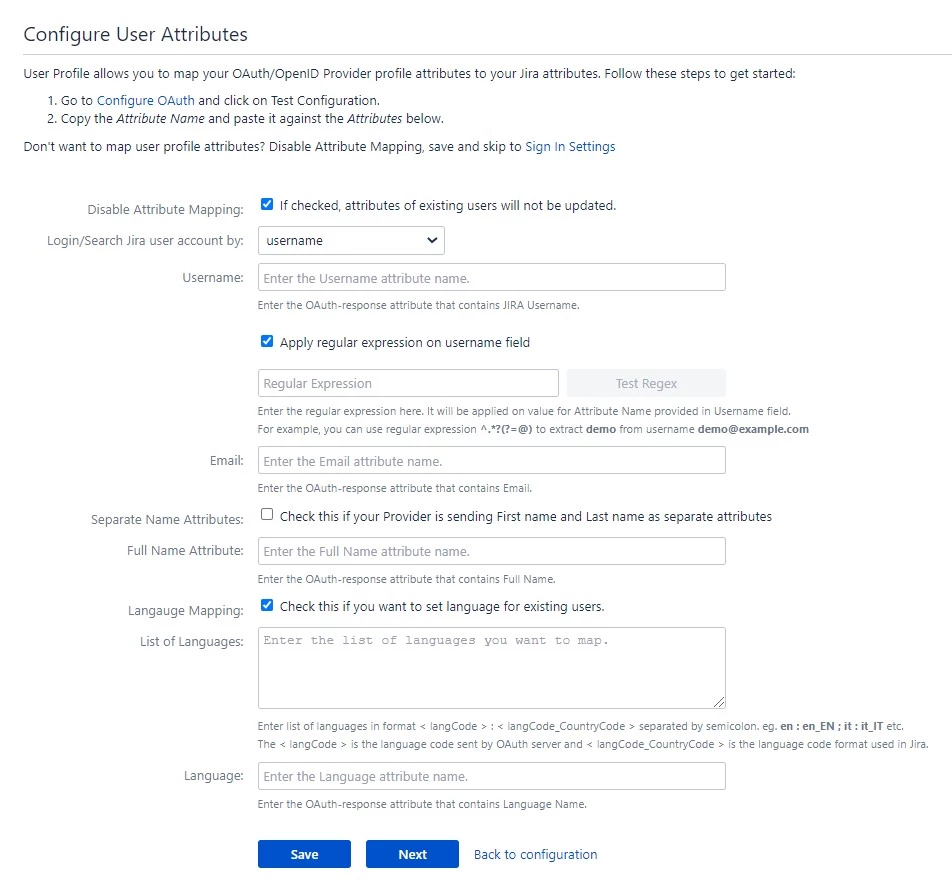
3.1 Identifying Correct Attributes
3.2 Configuring Profile Attributes
3.3 User Attribute Matching
When a user logs into Jira, data or attributes from the OAuth/OpenID provider are used to search for that user in Jira and facilitate login. To match the attributes:
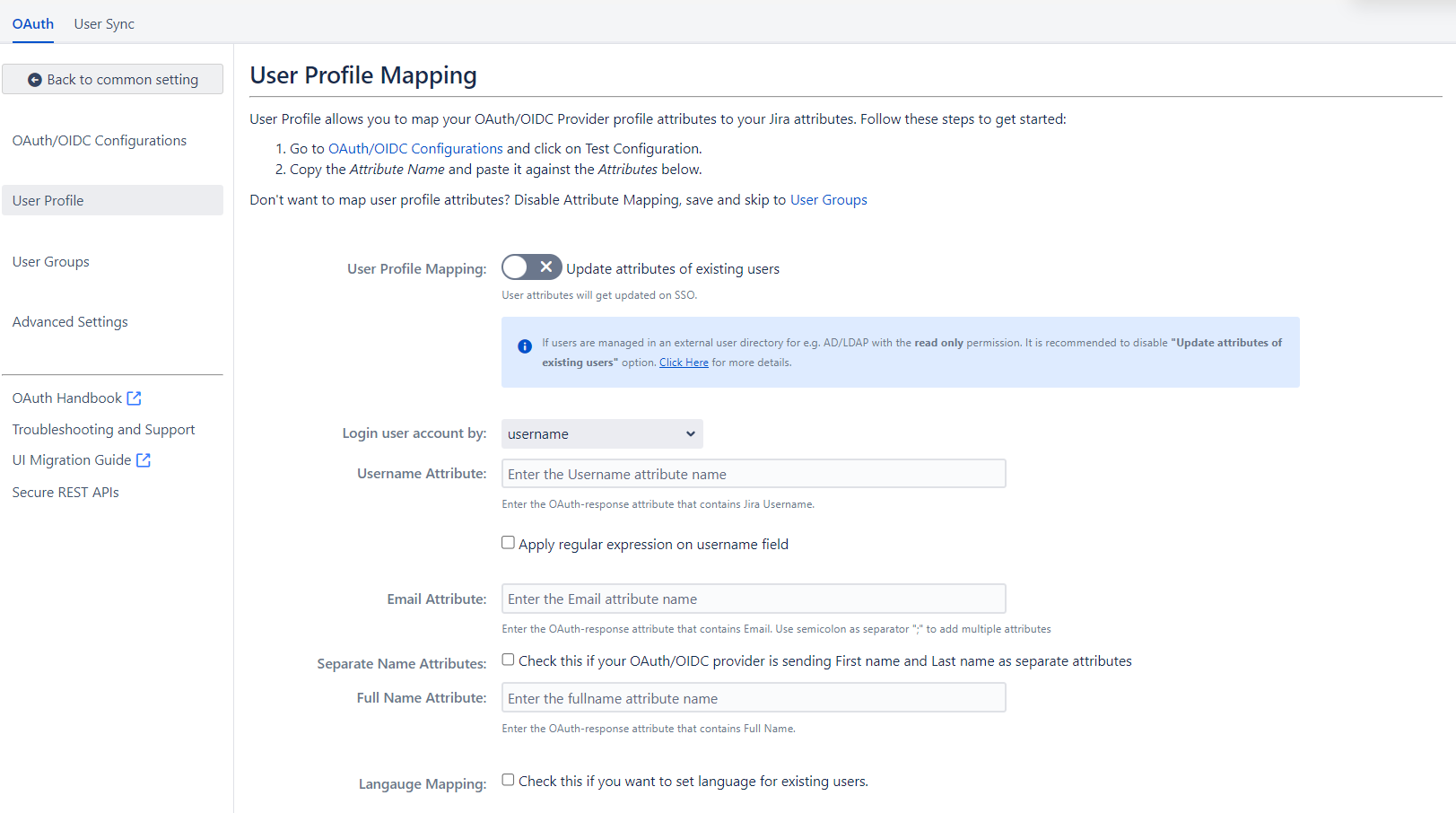
3.4 Custom Attribute Mapping
You can configure custom attributes received in the OAuth/OpenID response using the Configure User Properties(Extended Attributes) section.
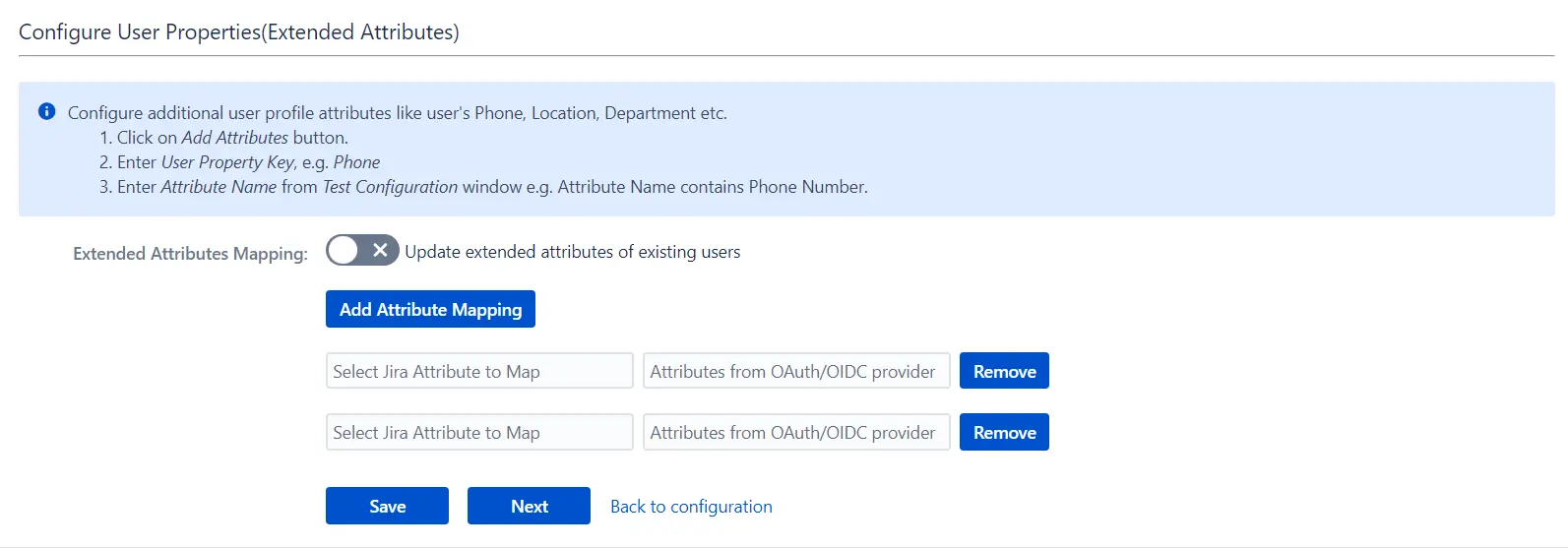
Step 4: User Group Mapping
- In the User Groups tab, select the default group for users. If no group is mapped, users are automatically added to this group.
- Using the Assign Default Group To option, you can assign default groups to all users or new users. Choose None if you prefer not to assign any default group to SSO users.
- To identify group attributes, go to the Configure OAuth tab and click on Test Configuration. Review the values returned by your OAuth/OpenID provider to Jira in the table. If group values are missing, adjust the settings in your OAuth provider to include group names.
- After reviewing all values in Test Configuration, proceed to the User Groups tab. Enter the Attribute Name of the group under Group Attribute.
- Check Disable Group Mapping option if you don't want to update groups of existing users.
- Manual group mapping: If the names of groups in Jira are different than the corresponding groups in OAuth/OpenID Provider, then you should use Manual group mapping.
- On-The-Fly group mapping: If the names of groups in Jira and OAuth/OpenID Provider are same, you should use On-The-Fly group mapping.
As we proceed to configure user group attributes for Jira, you have the option to enable group mapping.
If you wish to do so, please ensure to select Enable Group Mapping in the User Groups tab. Alternatively, you can proceed directly to setting the default group.
4.1 Setting the Default Group

4.2 Finding Group Attribute
4.3 Group Mapping
Group mapping can be done manually or on the fly:
-
4.3.1 Manual Group Mapping
- Check the Allow User Creation based on Group Mapping option if you want new users to be created only if at least one of the user's OAuth/OpenID Provider groups is mapped to a group in the application.
- Select a Jira group from the dropdown list and enter the name of the OAuth/OpenID Provider group to be mapped in the Groups from Applications textbox.
- For instance, if you want all users in the 'dev' group of OAuth/OpenID providers to be added to jira-software-users, you will need to select jira-software-users from the dropdown and enter 'dev' against jira-software-users.
- You can use the '+' and '+10' buttons to add extra mapping fields, and the '-' button to delete mappings.
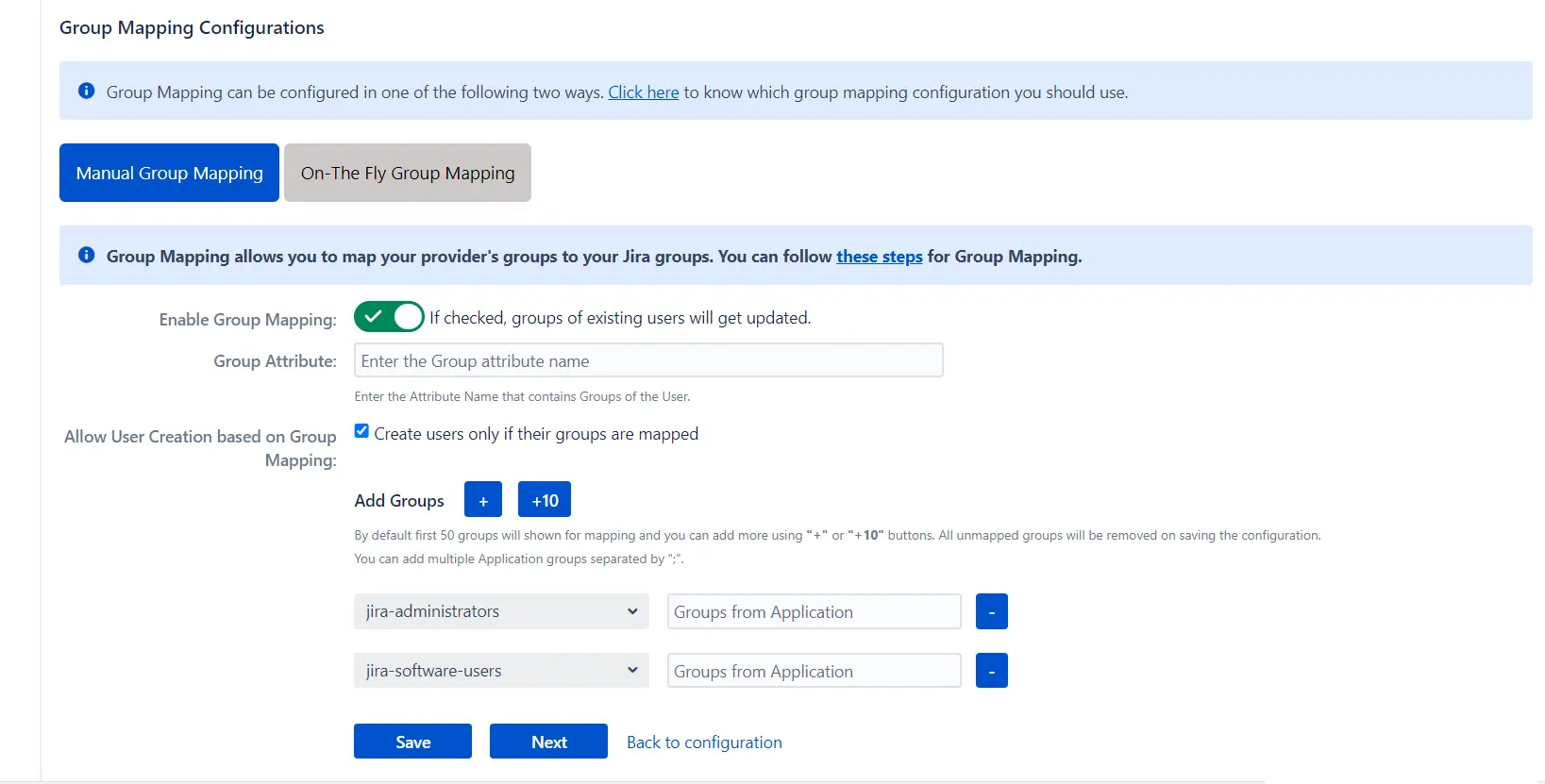
-
4.3.2 On-The Fly Group Mapping
- If the group names in both Jira and the OAuth/OpenID provider match, opt for On-The-Fly group mapping.
- Check the Create New Groups option to create new groups from the OAuth/OpenID Provider if not found in Jira.
- Preserve existing user groups by selecting the Keep Existing User Groups option. Unticking this option will remove the user from a Jira group if it's not present in the OAuth/OpenID response.
- Deselect the Keep Existing User Groups option to prevent On-The-Fly group mapping from affecting locally managed Jira groups. Add those groups to the Exclude Groups field.
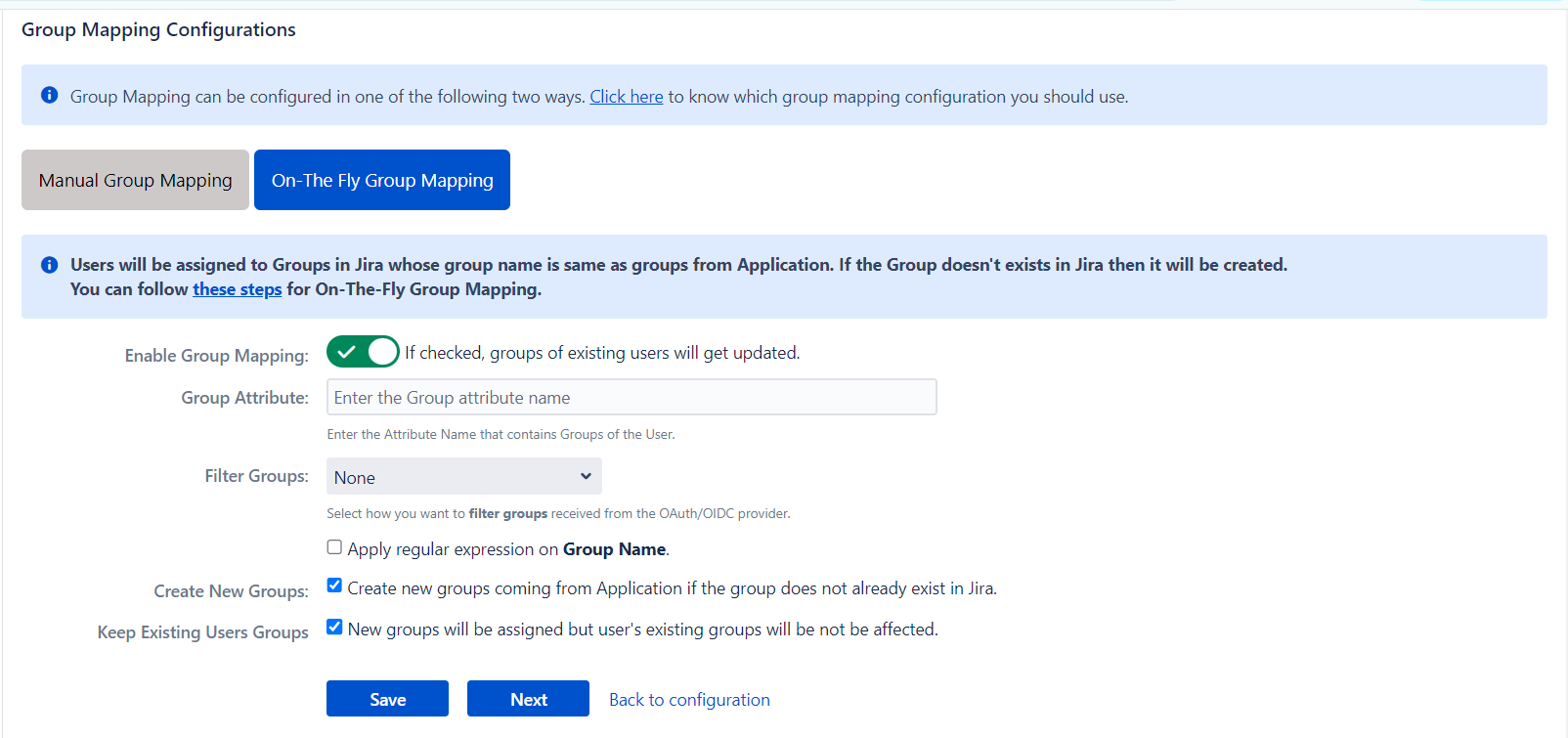
Step 5: SSO Setting
- Enable Auto Redirect to Application to redirect users to the OAuth/OIDC provider when accessing the Jira login page. You can set a delay before redirection.
- Next, toggle the Enable Backdoor Login option for emergency access using a backdoor URL. Restrict access to this URL for specific groups if needed.
- You can use Domain Restriction to allow login for specific user domains and configure multiple allowed domains (semicolon-separated).
- The Secure Admin Login option ensures the re-authentication of admin users before accessing pages with administrative permissions.
- Redirection rules allow you to redirect users to login pages/providers based on their email domains. This functionality is especially useful with multiple configured providers.
- To create a new rule, go to the Redirection Rules tab and click Add Rule.
- Next, give the rule a name and set the conditions for redirection. Click Save once you’re done.
- You can also set a default rule if no other rule conditions are met.
- Once you set a redirection rule, users who fulfill its conditions will be shown a login form, prompting them to input their username/email address. You can set domain-based rules for directing users to specific providers as well.
- You can enable/disable SSO for Jira Software and Service Desk from the Global SSO Settings tab.
- If enforcing SSO for Service Desk Agents only, select Enable SSO Only For Service Desk Agents.
- You have the option to activate SSO for both Jira software and service desk by selecting Enable SSO for Jira Software and Enable SSO for Jira Service Desk respectively.
- The app also gives you options to adjust additional settings like Allow Users to Change Password, Restrict Access to Plugin APIs, and Auto Activate Users on SSO.
- To keep users logged in until explicitly logged out, you can enable Remember Me-Cookie in the Session Management tab.
- You can customize the appearance of your login page and error messages from the Look and Feel tab.
- The plugin has provisions for modifying the default login button text and designing the login page using customisable templates.
- You can also set a Custom Logout URL from the Post Logout Configuration tab to redirect users to a specific screen after they logout.
- The SSO Error Message section allows you to customize the error message displayed to users.
The configurations within the SSO Settings tab are pivotal in shaping the user experience for Single Sign-On.
5.1 Sign In Settings
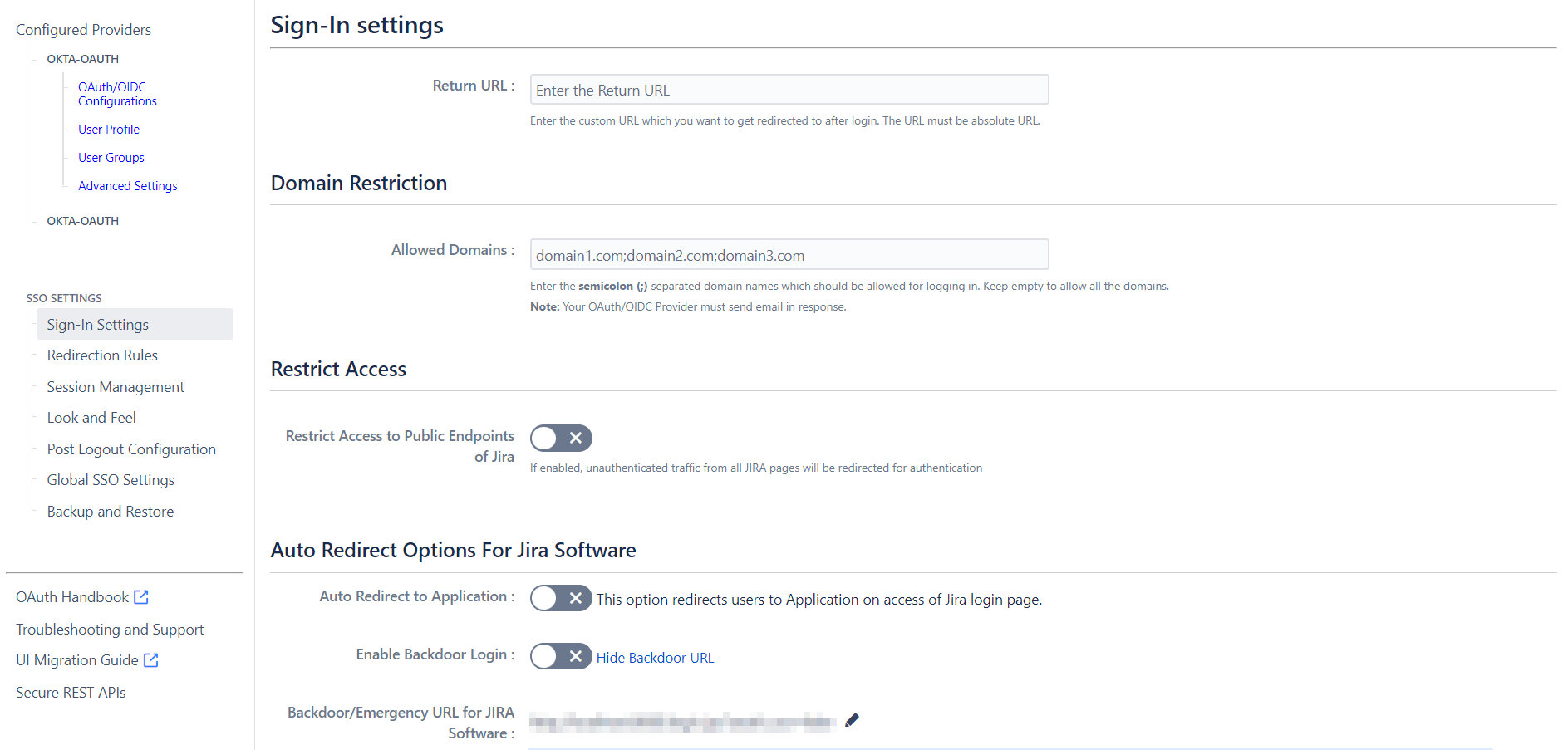
5.2 Redirection Rules
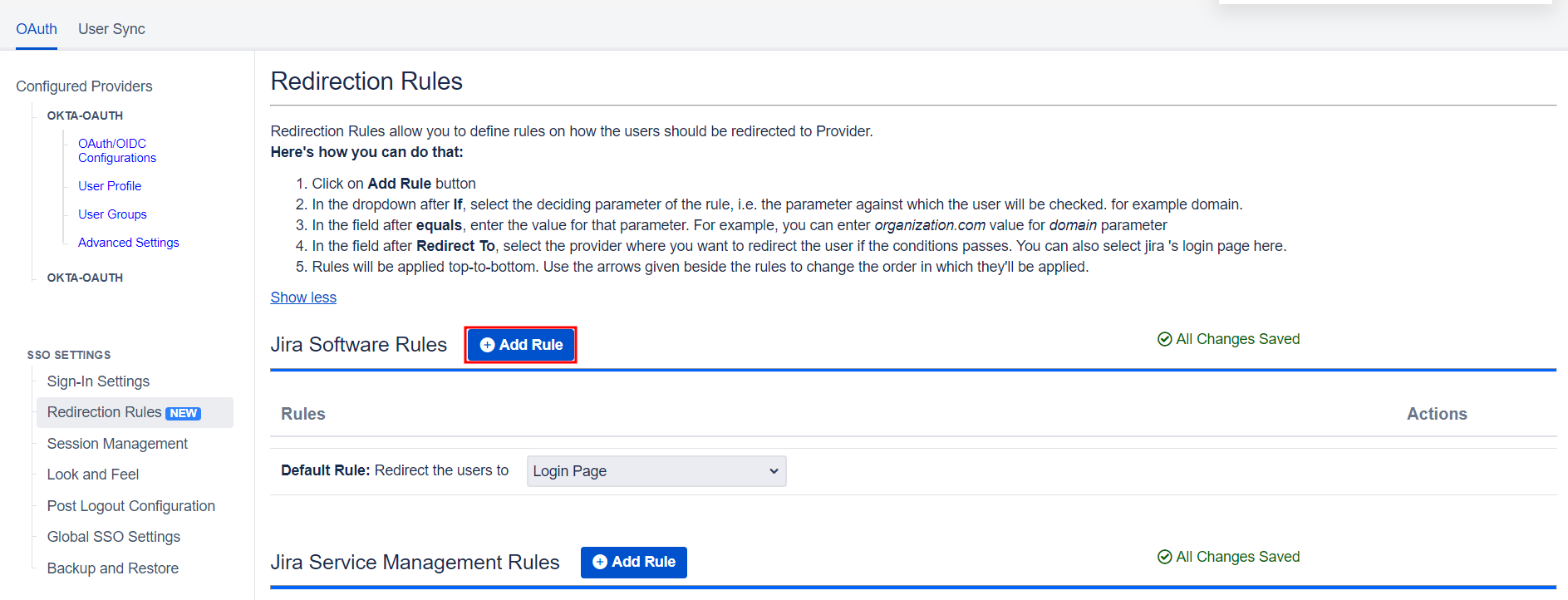


5.3 Global SSO Settings
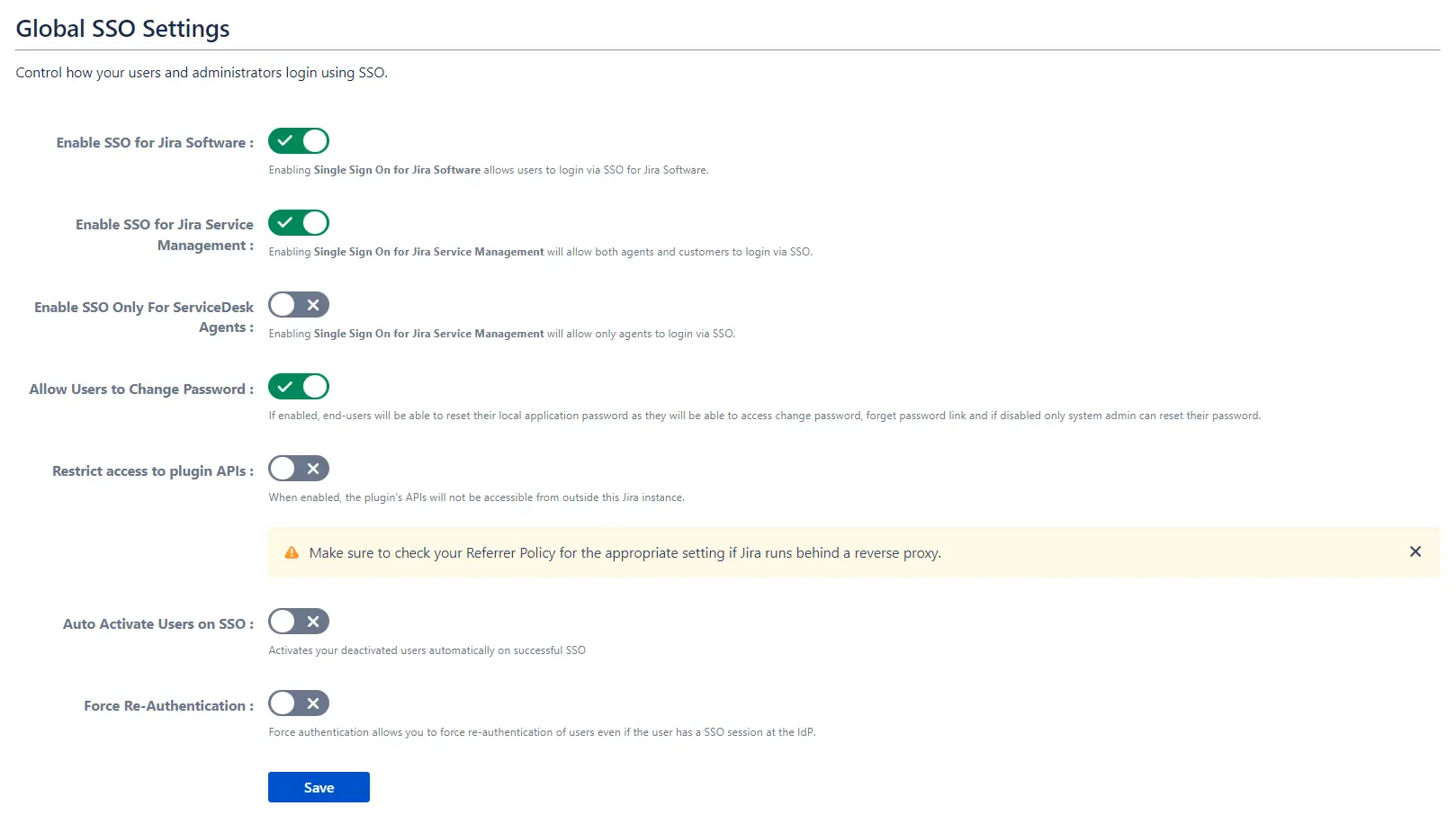
5.4 Look and Feel
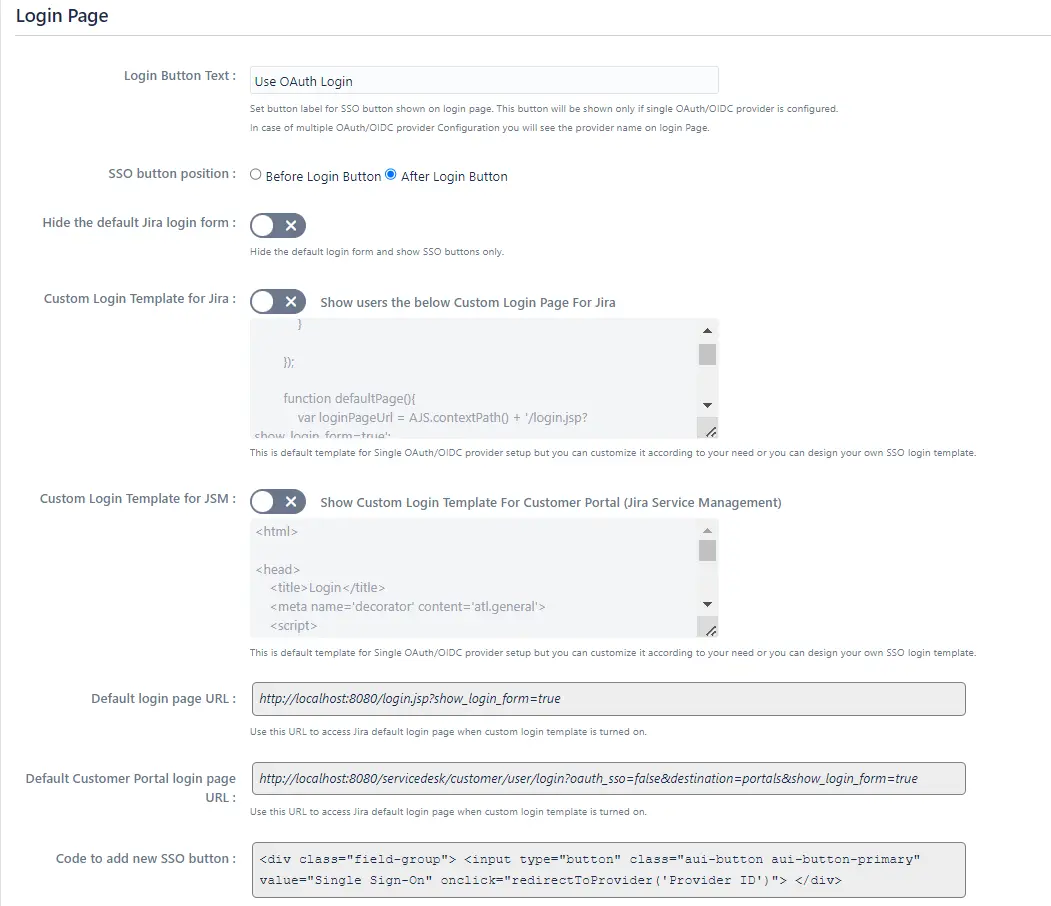
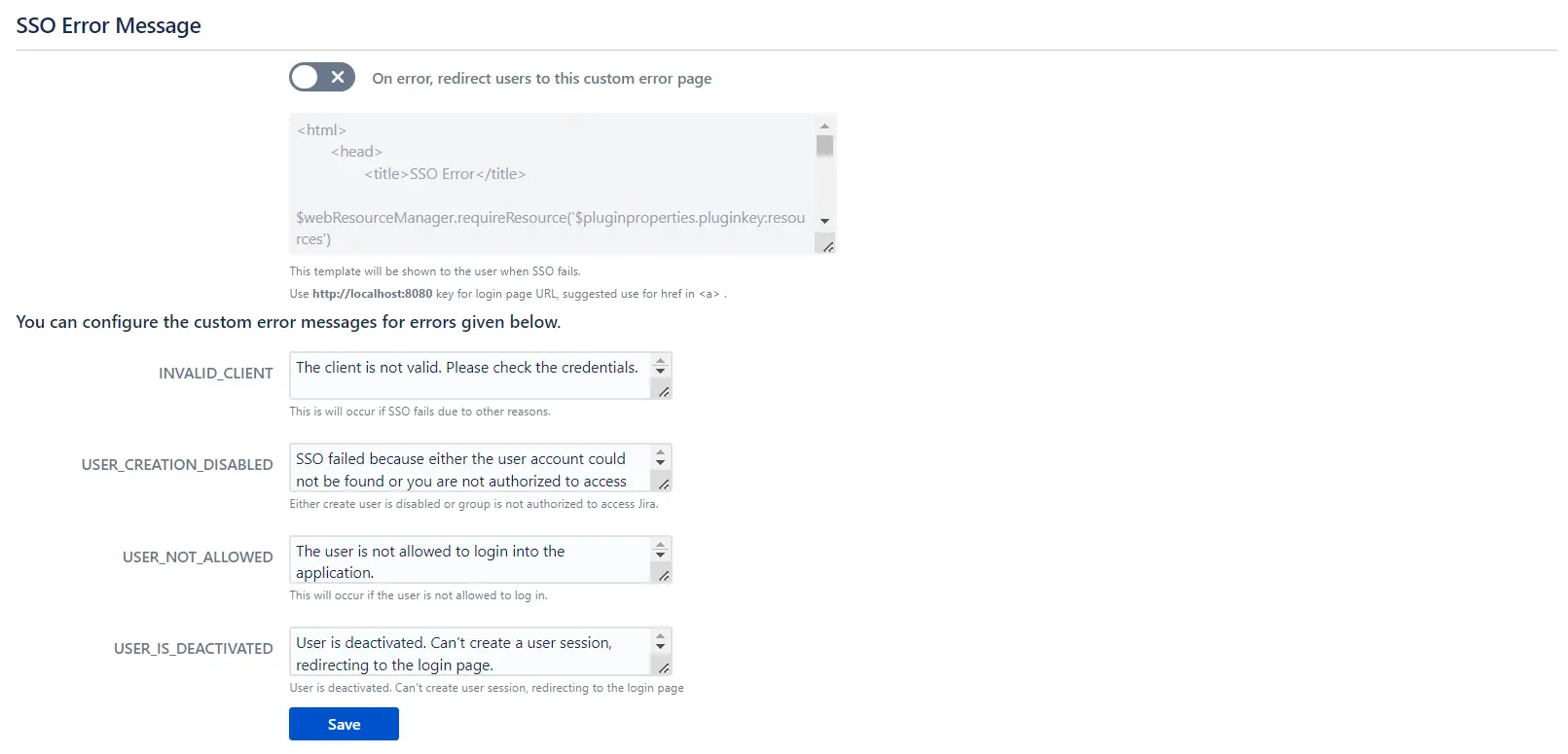
Configure SCIM with OAuth
 Hi! Do you need help with this guide?
Hi! Do you need help with this guide?
Thank you for your response. We will get back to you soon.
Something went wrong. Please submit your query again

Recommended Add-Ons

Two Factor Authentication
Enable 2FA/MFA for users & groups and let users configure 2FA during their first login.
Know More
User Sync SCIM Provisioning
Synchronize users, groups & directory with SCIM & REST APIs for Server/DC.
Know More
API Token Authentication
Secure your JIRA Data Center/Server REST API using API Tokens.
Know More